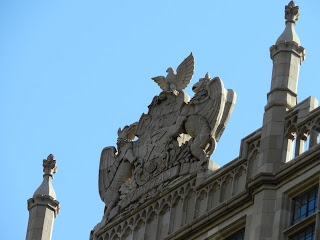My last few posts celebrated a couple of the elaborate garden apartment complexes in the historic district of Jackson Heights, Queens, where I spent an enjoyable afternoon walking, exploring, and discovering interesting things around every corner. The main purpose of our visit, however, was the Open House New York Weekend, a celebration of the city's "built environment", in which hundreds of culturally and architecturally significant places in all five boroughs are showcased.
I took several walking tours during the weekend; one of the best was a tour of Tudor City, the first residential skyscraper complex in the world. That's my tour group above, standing at the cul-de-sac at the east end of 43rd street that overlooks the United Nations. In fact, in the picture below, you can see the midtown New York skyline, including the Chrysler building, reflected in the U.N. across First Avenue from where we were standing. That cul-de-sac, by the way, is set to become a pedestrian plaza very soon-- no more cars or parking allowed.
This helps illustrate Tudor City's enviable location; it is literally right in the middle of Manhattan, just a couple of blocks east of Grand Central Terminal. As you walk east on 42nd Street from Grand Central, you will easily spot Tudor City-- a giant sign atop one of the eleven high-rises has announced its presence since 1928.
Tudor City, between East 41st and East 43rd Streets, and 1st and 2nd Avenues, in midtown Manhattan. Developer Fred French began construction of the skyscraper complex in 1925 in an area that had become a slum. He envisioned Tudor City as a "city within a city", and hoped to lure middle class families who were abandoning the city for the outer boroughs (see my two previous postings on Jackson Heights). The buildings are big, but at street level, Tudor City has a village atmosphere. One reason for this is the series of parks within the development.
The other attribute that creates a sense of a self-contained community is the topography, which includes a granite cliff overlooking First Avenue. While other nearby streets slope down from Second to First Avenue, East 41st and 43rd streets slope up and end at the cliff, providing natural separation on three sides. East 42nd Street cuts through the cliff and bisects Tudor City; a viaduct over 42nd Street connects the two sides of the development.
About five thousand people live in Tudor City. That's a lot of people...but these are big buildings with a lot of apartments!
The apartments are mostly oriented inward, with views of Tudor City's parks. Fewer windows are oriented on the eastern side toward the river. The reason is simple: in the 1920's the view in that direction was not desirable. Slaughterhouses, tanneries, breweries, and crowded tenements sat between the site of Tudor City and the East River. The view is quite different today!
Tudor City is named for England's Tudor dynasty, and Tudor-style ornamentation runs rampant on the buildings. Gargoyles, dragons, stonework, and inscriptions can be seen everywhere.
Tudor City dodged a major bullet in the 1980's when developer Harry Helmsley owned it and attempted to build new high-rises on the parkland inside the development. Residents fought him and won. The complex was designated a historic district in 1988. Fred French's enclave, his city within a city, retained its parks and its character, and remains a unique community in the heart of New York.

















No comments:
Post a Comment